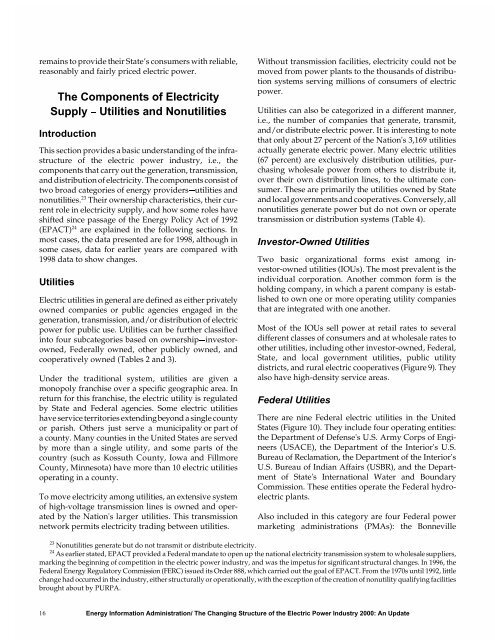The Changing Structure of the Electric Power Industry 2000: An ... - EIA
The Changing Structure of the Electric Power Industry 2000: An ... - EIA
The Changing Structure of the Electric Power Industry 2000: An ... - EIA
You also want an ePaper? Increase the reach of your titles
YUMPU automatically turns print PDFs into web optimized ePapers that Google loves.
emains to provide <strong>the</strong>ir State’s consumers with reliable,<br />
reasonably and fairly priced electric power.<br />
23 Nonutilities generate but do not transmit or distribute electricity.<br />
24 As earlier stated, EPACT provided a Federal mandate to open up <strong>the</strong> national electricity transmission system to wholesale suppliers,<br />
marking <strong>the</strong> beginning <strong>of</strong> competition in <strong>the</strong> electric power industry, and was <strong>the</strong> impetus for significant structural changes. In 1996, <strong>the</strong><br />
Federal Energy Regulatory Commission (FERC) issued its Order 888, which carried out <strong>the</strong> goal <strong>of</strong> EPACT. From <strong>the</strong> 1970s until 1992, little<br />
change had occurred in <strong>the</strong> industry, ei<strong>the</strong>r structurally or operationally, with <strong>the</strong> exception <strong>of</strong> <strong>the</strong> creation <strong>of</strong> nonutility qualifying facilities<br />
brought about by PURPA.<br />
16<br />
<strong>The</strong> Components <strong>of</strong> <strong>Electric</strong>ity<br />
Supply �� Utilities and Nonutilities<br />
Introduction<br />
This section provides a basic understanding <strong>of</strong> <strong>the</strong> infrastructure<br />
<strong>of</strong> <strong>the</strong> electric power industry, i.e., <strong>the</strong><br />
components that carry out <strong>the</strong> generation, transmission,<br />
and distribution <strong>of</strong> electricity. <strong>The</strong> components consist <strong>of</strong><br />
two broad categories <strong>of</strong> energy providers�utilities and<br />
nonutilities. 23 <strong>The</strong>ir ownership characteristics, <strong>the</strong>ir current<br />
role in electricity supply, and how some roles have<br />
shifted since passage <strong>of</strong> <strong>the</strong> Energy Policy Act <strong>of</strong> 1992<br />
(EPACT) 24 are explained in <strong>the</strong> following sections. In<br />
most cases, <strong>the</strong> data presented are for 1998, although in<br />
some cases, data for earlier years are compared with<br />
1998 data to show changes.<br />
Utilities<br />
<strong>Electric</strong> utilities in general are defined as ei<strong>the</strong>r privately<br />
owned companies or public agencies engaged in <strong>the</strong><br />
generation, transmission, and/or distribution <strong>of</strong> electric<br />
power for public use. Utilities can be fur<strong>the</strong>r classified<br />
into four subcategories based on ownership�investorowned,<br />
Federally owned, o<strong>the</strong>r publicly owned, and<br />
cooperatively owned (Tables 2 and 3).<br />
Under <strong>the</strong> traditional system, utilities are given a<br />
monopoly franchise over a specific geographic area. In<br />
return for this franchise, <strong>the</strong> electric utility is regulated<br />
by State and Federal agencies. Some electric utilities<br />
have service territories extending beyond a single county<br />
or parish. O<strong>the</strong>rs just serve a municipality or part <strong>of</strong><br />
a county. Many counties in <strong>the</strong> United States are served<br />
by more than a single utility, and some parts <strong>of</strong> <strong>the</strong><br />
country (such as Kossuth County, Iowa and Fillmore<br />
County, Minnesota) have more than 10 electric utilities<br />
operating in a county.<br />
To move electricity among utilities, an extensive system<br />
<strong>of</strong> high-voltage transmission lines is owned and operated<br />
by <strong>the</strong> Nation's larger utilities. This transmission<br />
network permits electricity trading between utilities.<br />
Without transmission facilities, electricity could not be<br />
moved from power plants to <strong>the</strong> thousands <strong>of</strong> distribution<br />
systems serving millions <strong>of</strong> consumers <strong>of</strong> electric<br />
power.<br />
Utilities can also be categorized in a different manner,<br />
i.e., <strong>the</strong> number <strong>of</strong> companies that generate, transmit,<br />
and/or distribute electric power. It is interesting to note<br />
that only about 27 percent <strong>of</strong> <strong>the</strong> Nation's 3,169 utilities<br />
actually generate electric power. Many electric utilities<br />
(67 percent) are exclusively distribution utilities, purchasing<br />
wholesale power from o<strong>the</strong>rs to distribute it,<br />
over <strong>the</strong>ir own distribution lines, to <strong>the</strong> ultimate consumer.<br />
<strong>The</strong>se are primarily <strong>the</strong> utilities owned by State<br />
and local governments and cooperatives. Conversely, all<br />
nonutilities generate power but do not own or operate<br />
transmission or distribution systems (Table 4).<br />
Investor-Owned Utilities<br />
Two basic organizational forms exist among investor-owned<br />
utilities (IOUs). <strong>The</strong> most prevalent is <strong>the</strong><br />
individual corporation. <strong>An</strong>o<strong>the</strong>r common form is <strong>the</strong><br />
holding company, in which a parent company is established<br />
to own one or more operating utility companies<br />
that are integrated with one ano<strong>the</strong>r.<br />
Most <strong>of</strong> <strong>the</strong> IOUs sell power at retail rates to several<br />
different classes <strong>of</strong> consumers and at wholesale rates to<br />
o<strong>the</strong>r utilities, including o<strong>the</strong>r investor-owned, Federal,<br />
State, and local government utilities, public utility<br />
districts, and rural electric cooperatives (Figure 9). <strong>The</strong>y<br />
also have high-density service areas.<br />
Federal Utilities<br />
<strong>The</strong>re are nine Federal electric utilities in <strong>the</strong> United<br />
States (Figure 10). <strong>The</strong>y include four operating entities:<br />
<strong>the</strong> Department <strong>of</strong> Defense's U.S. Army Corps <strong>of</strong> Engineers<br />
(USACE), <strong>the</strong> Department <strong>of</strong> <strong>the</strong> Interior's U.S.<br />
Bureau <strong>of</strong> Reclamation, <strong>the</strong> Department <strong>of</strong> <strong>the</strong> Interior's<br />
U.S. Bureau <strong>of</strong> Indian Affairs (USBR), and <strong>the</strong> Department<br />
<strong>of</strong> State's International Water and Boundary<br />
Commission. <strong>The</strong>se entities operate <strong>the</strong> Federal hydroelectric<br />
plants.<br />
Also included in this category are four Federal power<br />
marketing administrations (PMAs): <strong>the</strong> Bonneville<br />
Energy Information Administration/ <strong>The</strong> <strong>Changing</strong> <strong>Structure</strong> <strong>of</strong> <strong>the</strong> <strong>Electric</strong> <strong>Power</strong> <strong>Industry</strong> <strong>2000</strong>: <strong>An</strong> Update

















